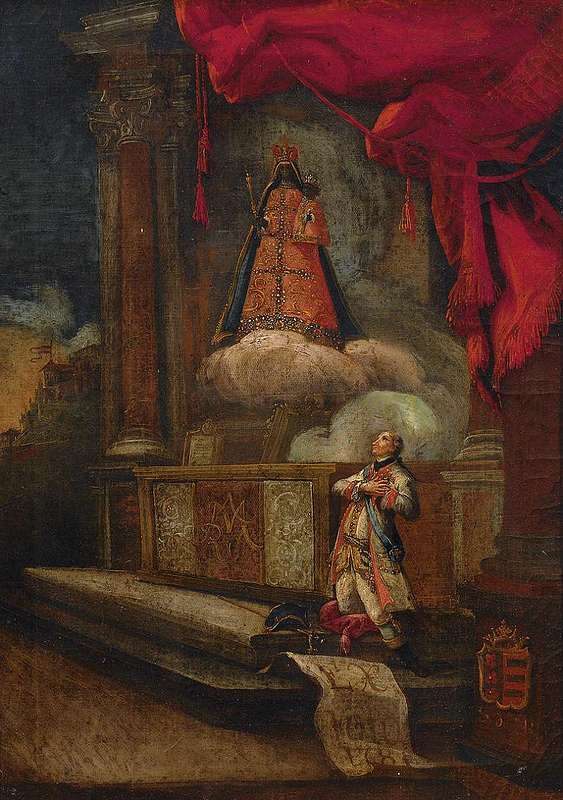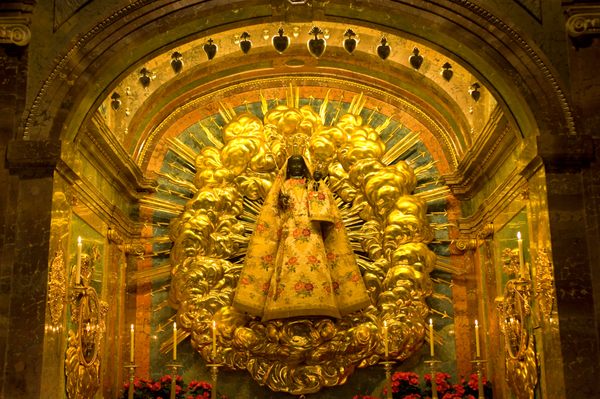When Hannes Flück was in high school, he volunteered on an archaeological dig and excavated a small Madonna figurine from the wall of a Swiss peasant farmhouse. Now a science curator at the Ziegelei Museum in Switzerland, Flück remembers the clay figure, two thirds of it scraped away.
“It was a bit surprising because I didn’t know what it was,” he recalls. It wasn’t until a colleague from the official state archaeological service explained it to him that he understood the significance of his find.
The scientists overseeing the dig estimated it was from the 18th or 19th century, when the tradition of scraping off pieces of consecrated Marian statues and eating them flourished in Medieval Europe. The figurines—called Schabmadonna—tell a story about the folk power of ingesting sacred edibles.
The term Schabmadonna takes its root from the German schaben, meaning to scrape or shave. It refers to unfired terracotta figurines produced by the Abbey of Einsiedeln in central Switzerland. They were sold to pilgrims who had come to revere the Black Madonna of Einsiedeln (also called “Our Lady of the Hermits”), a black statue housed in the abbey’s Chapel of Grace. Pilgrims would then take home the figurines—miniature replicas of the Black Madonna—as souvenirs and scrape off clay sherds or powder, eating the scrapings mixed with everyday food or drink as a form of medicine.

According to Flück, who now oversees several complete figurines on display at the museum, the Schabmadonna’s heyday fell between the 16th and 19th centuries when Christians believed the objects had “the potential to do miracles.” Flück notes these miracles could range from extinguishing fire to calming the sea to curing health problems. In Medieval Europe, practices of superstition and religious tradition often overlapped, as faith was based in the everyday, the physical, and the intimate. As medicine was largely an unsanitary and scary affair amid repeated plagues, sacred edibles were often considered the best option. To supplement the figurines, there were also amulets that could be carried alongside the Schabmadonna, made in the image of a body part or a symbol representing a disease or ailment such as a stomach for gastritis or a heart for palpitations.
Schabmadonnen are just one example of a wider pilgrimage souvenir market at the time. Medieval entrepreneurs in Bethlehem, for example, also sold scrapings from the Milk Grotto, a cave where the Virgin Mary was said to have spilt her breast milk. The resulting powder was believed to be a cure for infertility when mixed with water.
At Einsiedeln, monks made Schabmadonnen by squeezing clay into shape using incised handle presses, then consecrating the resulting figurines. According to a paper by Adriano Boschetti-Maradi, a professor of Medieval archaeology at the University of Zurich, the abbey even advertised that each Schabmadonna contained dust from the Chapel of Grace. Unlike a secondary relic—such as a piece of paper or fabric that touched a first-class relic like a saint’s bones, teeth, or hair—that a person could kiss, pray over, or hold to their face, Schabmadonnen allowed people to become one with specks of dust that may have once come from the Black Madonna itself.

Like any highly coveted commodity, there were Schabmadonna knockoffs sold by merchants in Einsiedeln and the surrounding areas up until the 1920s. Private citizens also sold figurines that were later consecrated inside the monastery and considered effective. Archaeologists are now able to distinguish Schabmadonnen created by the monks from these imitation figures because the former usually bears a raven, the symbol of St. Meinrad, the German Benedictine hermit who founded the abbey in the ninth century.
Katharina Wilkens, a lecturer at the Institute for the Study of Religions University of Tübingen in Germany, has been researching spiritual edibles for more than a decade. She’s seen evidence that people have used Schabmadonnen up until two generations ago, having met people whose grandparents remembered buying and scraping Schabmadonna as recently as the mid-1900s.
In her paper, “Drinking the Quran, Swallowing the Madonna,” Wilkens likens the practice of Schabmadonna to a sacred edible tradition in Islam. Although there is no agreed-upon start date for the practice, some Muslims today still write Quranic verses in ink on a plate, bowl, or paper, and dissolve them in water. The person then drinks the water, believed to be infused with the power of the verses, as a form of traditional medicine. Often, the verses are tailored to the person’s ailment.

In the case of both the Schabmadonna and drinking the Quran, the act of consuming something is more important than its nutritive value, as people doing so believe that it transforms them. This is also the belief behind transubstantiation and the ingesting of Communion wafers, but prior to the Protestant Reformation, many lay people did not have regular access to the Eucharist. Since the monk-consecrated Schabmadonnen could be consumed by pilgrims of all classes and taken anywhere, they gave common people access to similar religious traditions.
The Abbey of Einsiedeln stopped producing Schabmadonnen in 1789. Flück attributes this fate to a combination of factors, including the decline of pilgrimages and the rise of the Enlightenment. Although the practice of ingesting Schabmadonnen continued locally, it largely faded away.
While you can no longer buy a Schabmadonna, you can make your own. The Ziegelei Museum offers a course where visitors can create their own medicinal Marys using a replica of a hermit’s handle press. It even comes with a paper explaining how some clays contain antibacterial and pollutant-binding properties. But, Flück cautions, the museum makes no claim that the souvenirs work miracles.
Gastro Obscura covers the world’s most wondrous food and drink.
Sign up for our email, delivered twice a week.

